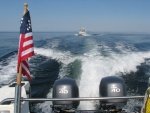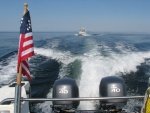Avidmagnum12
Member
- Joined
- Mar 23, 2013
- Messages
- 730
- Reaction score
- 14
- C Dory Year
- 2011
- C Dory Model
- 25 Cruiser
- Vessel Name
- C-Otter
I spent three days on the St. John’s River last week finding out what the autopilot would do.
I started by running in fairly calm conditions at normal cruise speed (about 6 mph) and ran as slow as 2.2 mph both up and down river. It held heading unbelievably well. We did the same with the Yamaha 9.9 hi thrust and outcome was the same. The autopilot worked flawlessly at 15 to 35 mph.
The next day we had 1 1/2 to 2 footers on Lake Monroe. No surprise the only challenge we had was with the kicker going into the waves at very slow speed. Just not enough power however at 4 to 5mph it did a good job. Down wind no problems at all. Top speed was limited to about 16 to 20 by the waves. We programmed different headings on the Garmin chart plotter and the Reactor held true every time.
My wife went along with the purchase but questioned it at first but after taking the helm she was completely sold. Does every C-Dory need an autopilot....No!
But for fishing, long distance cruising and thick fog it sure is a handy tool.
Jody....I love the controller bracket holder idea that You had. It keeps the unit handy at all times....Thanks.
Colby....see you at Hontoon. If you don’t get yours calibrated by then I’ll give you a hand 🖐.
Tom
I started by running in fairly calm conditions at normal cruise speed (about 6 mph) and ran as slow as 2.2 mph both up and down river. It held heading unbelievably well. We did the same with the Yamaha 9.9 hi thrust and outcome was the same. The autopilot worked flawlessly at 15 to 35 mph.
The next day we had 1 1/2 to 2 footers on Lake Monroe. No surprise the only challenge we had was with the kicker going into the waves at very slow speed. Just not enough power however at 4 to 5mph it did a good job. Down wind no problems at all. Top speed was limited to about 16 to 20 by the waves. We programmed different headings on the Garmin chart plotter and the Reactor held true every time.
My wife went along with the purchase but questioned it at first but after taking the helm she was completely sold. Does every C-Dory need an autopilot....No!
But for fishing, long distance cruising and thick fog it sure is a handy tool.
Jody....I love the controller bracket holder idea that You had. It keeps the unit handy at all times....Thanks.
Colby....see you at Hontoon. If you don’t get yours calibrated by then I’ll give you a hand 🖐.
Tom


